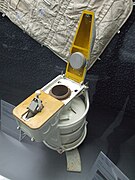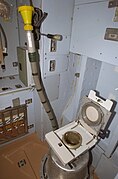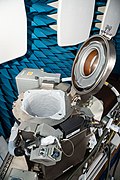Space toilet
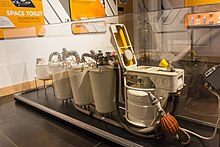
Aspace toiletorzero-gravity toiletis atoiletthat can be used in aweightlessenvironment. In the absence of weight, the collection and retention of liquid and solid waste is directed by use of airflow. Since the air used to direct the waste is returned to the cabin, it is filtered beforehand to control odor and cleanse bacteria. In older systems, wastewater is vented into space, and any solids are compressed and stored for removal upon landing. More modern systems expose solid waste tovacuumpressures to kill bacteria, which prevents odor problems and killspathogens.[1]
Background[edit]
Astronauts say that they are most often asked how they go to the bathroom in space.[2]In space,weightlessnesscauses fluids to distribute uniformly around human bodies.Kidneysdetect the fluid movement and a physiological reaction causes the humans to need to relieve themselves within two hours of departure fromEarth.The space toilet was thus the first device activated on shuttle flights, after astronauts unbuckled themselves.[3]
Mechanism[edit]
In the absence of gravity, space toilets use air flow to pull urine and feces away from the body and into the proper receptacles. A new feature of the space toilet is the automatic start of air flow when the toilet lid is lifted, which also helps with odor control. By popular (astronaut) demand, it also includes a more ergonomic design requiring less clean-up and maintenance time, with corrosion-resistant, durable parts to reduce the likelihood of maintenance outside of the set schedule. Less time spent on plumbing means more time for the crew to spend on science and other high-priority exploration focused tasks.[4]
The crew use a specially shaped funnel and hose for urine (suction cup) and the seat for bowel movements. The funnel and seat can be used simultaneously, reflecting feedback from female astronauts. The space toilet seat may look uncomfortably small and pointy, but in microgravity, it is ideal. It provides ideal body contact to make sure that everything goes where it should.[4]
The space toilet includes foot restraints and handholds for astronauts to keep themselves from floating away. Everyone positions themselves differently while "going", and consistent astronaut feedback indicated that the traditional thigh straps were a hassle.[4]
Toilet paper, wipes, and gloves are disposed of in water-tight bags. Solid waste in individual water-tight bags is compacted in a removable fecal storage canister. A small number of fecal canisters are returned to Earth for evaluation, but most are loaded into a cargo ship that burns up on re-entry through Earth's atmosphere. Currently, fecal waste is not processed for water recovery, but NASA is studying this capability.[4]
Basic parts[edit]

There are four basic parts in a space toilet: the liquid-waste vacuum tube, the vacuum chamber, the waste storage drawers, and the solid-waste collection bags. The liquid-waste vacuum tube is a 2-to-3-foot (61 to 91 cm) long rubber or plastic hose that is attached to the vacuum chamber and connected to a fan that provides suction. At the end of the tube is a detachable urine receptacle, which comes in different versions for male and female astronauts. The male urine receptacle is a plastic funnel 2 to 3 inches (5 to 8 cm) in width and about 4 inches (10 cm) deep. A male astronaut urinates directly into the funnel from a distance of 2 to 3 inches (5 to 8 cm) away. The female funnel is oval and is 2 by 4 inches (5 by 10 cm) wide at the rim. Near the funnel's rim are small holes or slits that allow air movement to prevent excessive suction. The vacuum chamber is a cylinder about 1-foot (30 cm) deep and 6 inches (15 cm) wide with clips on the rim, where waste collection bags may be attached and a fan that provides suction. Urine is pumped into and stored in waste storage drawers. Solid waste is stored in a detachable bag made of a special fabric that lets gas (but not liquid or solid) escape, a feature that allows the fan at the back of the vacuum chamber to pull the waste into the bag. When the astronaut is finished, he or she then twists the bag and places it in a waste storage drawer. Samples of urine and solid waste are frozen and taken to Earth for testing.
Designs[edit]
Space Shuttle Waste Collection System[edit]
The toilet used on theSpace Shuttleis called theWaste Collection System(WCS). In addition to air flow, it also uses rotating fans to distribute solid waste for in-flight storage. Solid waste is distributed in a cylindrical container, which is then exposed to vacuum to dry the waste. Liquid waste was disposed of by discharging it into space.[6][citation needed]
The WCS required many hours of training. For urination, a hose was used. For defecation, with a 4 inches (100 mm) diameter for the hole in the seat—much smaller than in a conventional toilet—the user's bottom needed to be exactly centered on the seat. NASA built a simulator with a video camera in the hole; those training used a crosshair to learn how to position their bodies, while other astronauts watched and made jokes.[7][2]
The WCS had several malfunctions in flight. On the eight-daySTS-3test flight, the toilet had broken down, and its two-man crew (Jack LousmaandGordon Fullerton) resorted to fecal containment devices (FCD) for waste elimination and disposal.[citation needed]An anomaly of the liquid disposal system onDiscoveryduringits maiden flightresulted in a buildup of frozen excrements outside the orbiter, which was then removed by means ofCanadarm.[6]DuringSTS-46,one of the fans malfunctioned, and crew memberClaude Nicollierwas required to perform in-flight maintenance (IFM).
International Space Station[edit]
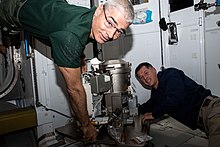
There are three toilets on theInternational Space Station,located in theZvezda,NaukaandTranquilitymodules.[8]They use a fan-driven suction system similar to theSpace ShuttleWCS. Liquid waste is collected in 20-litre (5.3 US gal) containers. Solid waste is collected in individual micro-perforated bags, which are stored in an aluminum container.[9]Full containers are transferred toProgressfor disposal. An additionalWaste and Hygiene Compartmentis part of theTranquilitymodule launched in 2010. In 2007, NASA purchased a Russian-made toilet similar to the one already aboard ISS rather than develop one internally.[10]
On May 21, 2008, the gas–liquid separator pump failed on the 7-year-old toilet in Zvezda, although the solid-waste portion was still functioning. The crew attempted to replace various parts, but was unable to repair the malfunctioning part. In the interim, they used a manual mode for urine collection.[11]The crew had other options: to use the toilet on theSoyuztransport module (which only has capacity for a few days of use) or to use urine-collection bags as needed.[12]A replacement pump was sent from Russia in adiplomatic pouch,so thatSpace Shuttle Discoverycould take it to the station as part of missionSTS-124on June 2.[13][14][15]
Other designs[edit]
TheSoviet/Russianspace stationMir's toilet also used a system similar to the WCS.[16]
While theSoyuz spacecrafthad an onboard toilet facility since its introduction in 1967 (due to the additional space in the Orbital Module), allGeminiandApollospacecraft required astronauts to urinate in a so-called "relief tube", in which the contents were dumped into space, while fecal matter was collected in specially-designed bags.[17]The facilities were so uncomfortable that, to avoid using them, astronauts ate less than half theavailable food on their flights.[18]TheSkylabspace station, used by NASA between May 1973 and March 1974, had an onboard WCS facility, which served as a prototype for the Shuttle's WCS, but also featured an onboard shower facility. The Skylab toilet, which was designed and built by the Fairchild Republic Corp. on Long Island, was primarily a medical system to collect and return to Earth samples of urine, feces and vomit, so that calcium balance in astronauts could be studied.
Even with the facilities, astronauts and cosmonauts for both launch systems employ pre-launch bowel clearing andlow-residue dietsto minimize the need fordefecation.[19]The Soyuz toilet has been used on a return mission from Mir.[16]
NPP Zvezdais a Russian developer of space equipment, which includes zero-gravity toilets.[20]
A $23 million next-generation space toilet called the Universal Waste Management System (UWMS) is being developed by NASA forOrionand the International Space Station.[21][22]The UWMS is the first space toilet designed specifically for women as well as men, easing the use of space toilets for women and use for stool and urine at the same time. It is designed to be fully automated, quieter, lighter, more reliable, more hygienic and more compact than previous systems.[21][23]Among its innovations, the UWMS relies on a3D printingtechnique to incorporate metals includingInconel,Elgiloy,andtitaniumthat can withstand the acids used to treat urine within the toilet.[23]The UWMS was first delivered to the ISS in October 2020.[24]
-
Toilet device on Soyuz spacecraft
-
Space Shuttle toilet
-
Russian space toilet used in space station Mir
-
A mockup of the toilet that would be carried on MOL
-
Zero-gravity toilet on theInternational Space Stationin theZvezda Service Module
-
Space toilet inside Node 3, after relocation from the US lab
-
ISS Universal Waste Management System
See also[edit]
References[edit]
- ^"Gigapan: Space Shuttle Discovery Toilet".National Geographic.National Geographic Society.Archivedfrom the original on September 5, 2013.RetrievedSeptember 8,2013.
- ^abShuttle's Toilet Requires Special Training(YouTube). NASA. May 5, 2010.Archivedfrom the original on December 14, 2021.
- ^Walker, Charles D. (March 17, 2005)."Oral History 2 Transcript"(PDF).NASA Johnson Space Center Oral History Project(Interview). Interviewed by Ross-Nazzal, Jennifer.RetrievedDecember 29,2011.
- ^abcdElburn, Darcy (August 2, 2019)."Boldly Go! NASA's New Space Toilet".NASA.RetrievedFebruary 7,2022.
 This article incorporates text from this source, which is in thepublic domain.
This article incorporates text from this source, which is in thepublic domain.
- ^NASA (November 15, 2001)."Configuration Changes and Certification Status – Shuttle Urine Pre-treat Assembly"(PDF).STS-108 Flight Readiness Review.Archived fromthe original(PDF)on November 8, 2004.RetrievedDecember 28,2006.
- ^ab"35 Years Ago: STS-41D – First Flight of Space Shuttle Discovery - NASA".August 30, 2019.RetrievedDecember 16,2023.
- ^Croft, Melvin; Youskauskas, John (2019).Come Fly with Us: NASA's Payload Specialist Program.Outward Odyssey: a People's History of Spaceflight. University of Nebraska Press. p. 15.ISBN9781496212252.
- ^Cheryl L. Mansfield (November 7, 2008)."Station Prepares for Expanding Crew".NASA.RetrievedSeptember 17,2009.
- ^Lu, Ed (September 8, 2003)."HSF – International Space Station –" Greetings Earthling "".Archived fromthe originalon September 6, 2003.RetrievedDecember 21,2006.
- ^Fareastgizmos (July 6, 2007)."19 million US Dollars for a space station toilet".RetrievedJuly 9,2007.
- ^"Toilet trouble for space station".BBC News.May 29, 2008.RetrievedJanuary 4,2010.
- ^"Space station struggles with balky toilet".NBC News.
- ^"Astronauts To Fix Space Station Toilet".Archived fromthe originalon September 19, 2008.
- ^"ISS – Zvezda Bathroom Repairs and Shuttle Preps for Crew".Archived fromthe originalon July 15, 2012.
- ^"Space Station Toilet Parts Set for Liftoff".RedOrbit.May 29, 2008.
- ^abShuttleworth, Mark (February 9, 2002)."Toilet Training".First African in Space.RetrievedDecember 28,2006.
- ^Sandra Häuplik-Meusburger:Architecture for astronauts: an activity-based approach.Springer, 2011,ISBN978-3-7091-0666-2,Hygiene Apollo – Resume Toilett, p. 134–137.
- ^Bourland, Charles T. (April 7, 2006)."Charles T. Bourland".NASA Johnson Space Center Oral History Project(Interview). Interviewed by Ross-Nazzal, Jennifer.RetrievedDecember 24,2014.
- ^"Low Residue Diet".Buzzle. December 15, 2011. Archived fromthe originalon April 20, 2008.RetrievedMay 24,2012.
- ^"Assenisation Sanity Unit ASU-8A".Zvezda-npp.ru. Archived fromthe originalon February 13, 2012.RetrievedMay 24,2012.
- ^abJames L. Broyan Jr.; Michael K. Ewert; Patrick W. Fink (August 4, 2014)."Logistics Reduction Technologies for Exploration Missions"(PDF).NASA. Archived fromthe original(PDF)on October 6, 2014.RetrievedSeptember 28,2014.
- ^Grush, Loren (October 1, 2020)."NASA is about to launch an upgraded microgravity toilet to the International Space Station".The Verge.RetrievedOctober 3,2020.
- ^abThomas J. Stapleton; Shelley Baccus; James L. Broyan Jr. (January 1, 2013)."Development of a Universal Waste Management System"(PDF).NASA. Archived fromthe original(PDF)on October 6, 2014.RetrievedSeptember 28,2014.
- ^Melissa McKinley; Melissa Borrego; James Lee Broyan, Jr. (July 10, 2022)."NASA Universal Waste Management System and Toilet Integration Hardware Operations on ISS -- Issues, Modifications and Accomplishments"(PDF).RetrievedFebruary 7,2024.



